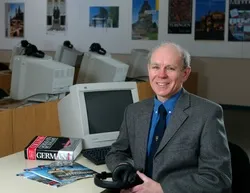The Engineer of Modern Languages

“Computers can handle more than just numbers and computations” says Dr. Tim Pope, of the University of Lethbridge Modern Languages Department. “They can deal with text just as easily, and wonderful possibilities open up when you can create custom computer programs.”
To prove that point, Tim pored over his first computer manual and, in 1984, wrote a computer program used for record keeping, data searching, and generating standard forms. In 1985, Tim attended a conference on possible uses for computers in teaching humanities and has never looked back. “Language is a system with rules and a standard word order,” he says. “So a computer is the perfect tool for modelling language, a task often called language engineering.”
When exploring the possibility of using computers to assist in learning a language, many aspects need to be considered. “The computer program must parallel human language, which means syntax is especially important,” Tim explains. “You feed the computer a sentence and it must be able to analyze it and determine component parts such as subject, object, and so on. It must be able to determine whether the sentence is grammatically correct.” They say necessity is the mother of invention, and soon Tim began developing programs that did just that.
The first step toward programs that analyze grammar was electronic dictionaries and bilingual databases. “In the late 1980s, the ability to link dictionaries through hypertext to verb tables, phrase books, and reference materials was a big step forward,” he says. “It’s been an interesting process.”
Tim notes that some languages are easier to model than others. German, for example, has a strong word order and numerous consistent rules. This makes it easier to program than English, which is a language of exceptions. To get some idea about how far technology has come during Tim’s career, he recounts the effort it took in the late 1980s to convince the university to buy an extra megabyte of memory: Then, “one megabyte cost $1,000.” Holding up a small memory stick, he says, “I just bought these eight gigabytes for less than $30.”
In 1989, Tim’s computer programs became a teaching tool in his language classes. “At that time we had to borrow the Management computer lab, computers were not networked, and there was no Windows operating system,” he recalls. By the mid 1990s things got really exciting: “We had the Internet and web-based software, sound, images and text, but still only stand-alone programs.” Then along came the Internet computer programming language Java and Tim wrote a program that enabled him to network computers in his German class.
“I was able to give students four or five interactive exercises, then have them write an online test, which was automatically emailed to me already graded,” he says. “This was a convenience to me, and students also enjoyed using it.” Tim has sold several of his programs around the world over the years but his latest, Webgen, has been freely shared with other universities.
And although computers make great teaching tools, there is still plenty of work for instructors. “Unfortunately, exercises don’t write themselves,” laments Tim. “And to be most effective, exercises should have varying levels of complexity and be personalized using local references, all of which takes work.”
Currently, computer assisted language learning (CALL) is valuable for students and professors. “The computer takes students individually through the same steps that would take me hours,” says Tim. “And computers are infinitely patient, I’m not.”
CALL is not like spellcheck, which fixes problems for the user; rather, the program analyzes input and exposes problems from which the student can learn. “The computer reviews individual words, word order and syntax to detect errors, and flags those errors for students, forcing them to think about what needs to be corrected. The computer also provides clues of increasing specificity to help students figure out problems,” Tim explains. “My objective is to have students learn and become competent in the language, not to give students a computerized cheat sheet.”
CALL gets good grades from students. “It holds their attention, is interactive, and uses multimedia,” he says. “Students get immediate feedback and can work at their own pace.” CALL has become a significant teaching tool. “By off-loading the repetitive drilling needed to learn a language onto the CALL lab, we have more time in class for other more genuine, oral activities. The lab work reinforces and supports classroom work,” he explains.
Currently, Tim is working on expanding Webgen for use in university Japanese classes this fall. “It was far easier than we thought to input and display Japanese,” he says. He is also looking ahead to the next challenge ? getting away from the keyboard and mouse. “I’m looking for a more human interface,” he says. “Speech recognition is the wave of the future.”
Katherine Wasiak
